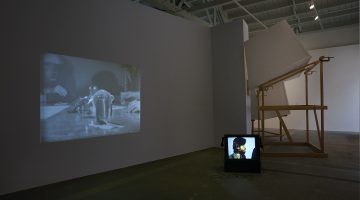
Andy Diaz Hope and Laurel Roth. Allegory of the Prisoner's Dilemma, 2012. Jacquard tapestry. Edition of 8 + 2 AP. 106 x 76 inches. Image courtesy of Catharine Clark Gallery.
At the opening of the group show “Punch Card” at Catharine Clark Gallery, artist Andy Diaz Hope said he and co-creator Laurel Roth wanted to make Jacquard tapestries that reflected Victorian enthusiasm for science. Emulating the political secrets coded in the 16th century “The Unicorn Tapestries,” Diaz Hope and Roth designed, digitized, and commissioned three works that triumph human accomplishment in “hard disciplines.” “Allegory of the Prisoner’s Dilemma” shows the succession of architectural achievement from when humans lived in caves into the future, when we reach the singularity (when artificial intelligence exceeds human intelligence). I’d like to think the outcome of the singularity/the cumulus clouds at the top of “…the Prisoner’s Dilemma” spire will be one ecstatic rave, but let’s not kid ourselves; the future will be dystopian. Human societies are the prisoners and the warden offered scientific knowledge and technological advancement as our Faustian bargain. The works in “Punch Card” venerate the glories of biology and technology, while acknowledging that a lot of those advancements amount to a deal with the Devil.

Stephanie Syjuco. Coverlet from Pattern Migration, 2011. Wool, loomed by Peggy Hart. Edition of 3. 96 x 72 inches. Image courtesy of Catharine Clark Gallery.
Stephanie Syjuco’s wool “Coverlet” and plastic bags were originally woven for her show “Pattern Migration” at the Columbus Museum of Art. In an interview with the museum, Syjuco said she was inspired by the outsourcing of manufacturing in America, a nineteenth century coverlet from the museum’s collection, and insanely cheap plaid plastic bags that are generally regarded as immigrant’s luggage (Columbus Museum). Syjuco recreated the plastic plaid in wool on a handloom and a commissioned old industrial loom in New England. She also commissioned the 19th-century coverlet design printed on plastic from Beijing. “Pattern Migration” is a story of America’s bygone days of American industry for an exploitative outsourcing system, and the ways that the advancement of the loom—which is highly mathematical—obviated the jobs of craftsmen. The Industrial Revolution was humanity’s deal with the Devil in that first-world countries got their wish, in bountiful inexpensive clothes, while developing countries destroy their environment and sacrifice their people in pursuit of economic development.

Andy Diaz Hope and Laurel Roth. Allegory of the Infinite Mortal, 2010. Jacquard tapestry. Edition of 8 + 2 AP. 106 x 76 inches. Image courtesy of Catharine Clark Gallery.
“Punch Card” refers to the jacquard loom that uses card stock with rectangular holes in it—producing chads—to control the loom and “correspond one-to-one to components of the design” (Catharine Clark). The same system was used for early computer programs. The jacquard loom’s punch card represents the upbeat of technological advancement, and, because the holes directly correspond to single colors of thread, it’s pixilation. Diaz Hope and Roth’s tapestries are true to the punch card in their digitally mapped designs, it’s just in another language. Up close, the tapestries have a blocky warp and weft of pink, white, and yellow threads; from a distance, they combine to the recognizable color of skin.

Devorah Sperber. After Warhol 1, 2008. Thread spools. Edition of 5. 42 x 25 x 66 inches. Image courtesy of Catharine Clark Gallery.
Devorah Sperber’s instillations dominate Catharine Clark’s galleries. Sperber is known for translating iconic images upside down, pixelated in spools of colored thread with an acrylic orb on a stand in front of them. Looking into the orb re-orients the Mona Lisa or Superman right-side-up and reduces its size beyond the point of visible pixelation, but you don’t need it to—the images are so omnipresent that you can easily recognize them upside down and abstracted into blocks of color. For a child, this is a fun optical trick. For an adult, it seems that the wonders of optics and visual language are being squandered on the same old things. Spectacularly, the gestalt effect would fill in and complete an unfamiliar image in my brain, even upside down. The pieces are a reminder of the price we’ve paid for gaining the ability to stamp out a million Mona Lisa keychains. The immense capacity for our brains to take in and play with new visual experiences is wasted on a modern world with a rigid visual vocabulary of repeating images and objects.

Nina Katchadourian. Mictlantechtli, 2004. Postcard and thread. 5 3:4 x 4 1:8 inches unframed, 8 1:8 x 6 1:8 inches framed. Image courtesy of Catharine Clark Gallery.
Intellectually cohesive art exhibits are rare, though plenty would have you think they have it together. “Punch Card” is united by criticality of technological advancement, Sperber’s and Diaz Hope/Roth’s optical gestalt effects, and in the neglected medium of textiles—and it’s a group show. It is conceptually taught without making a (futile) neat conclusion, but the evidence amounts to a vaguely queasy feeling that glorious technology has taken some very wrong turns. Catharine Clark credited her gallery’s marketing associate Stephanie Smith and registrar Juliann Crisp for coming up with the artists in “Punch Card” on short notice. They pulled off a curatorial hat trick that leaves the viewer wanting an alternative to the uncompromisingly positive history of technological advancement and a more measured (though probably less optimistic) prospectus for the future.
“Punch Card” is on view at Catharine Clark Gallery through February 23, 2013.
-Kendall George
Citation:
“CURRENTS: Stephanie Syjuco.” Columbus Museum. You Tube. 2011. Web 23 January 2013. http://www.youtube.com/watch?v=tQzXjKUX2Rw.


